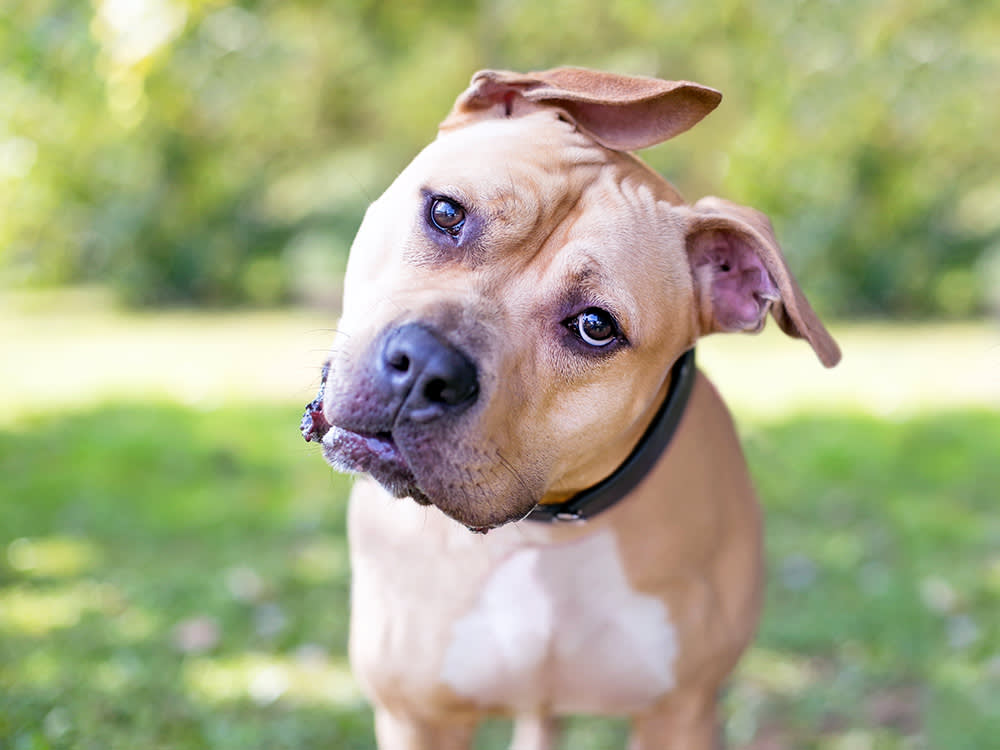Why Does My Dog Adorably Cock Their Head?
It’s not just ’cause its cute
Have you ever noticed your dog cocking their head in an adorably curious manner? It’s definitely one of the more endearing poses our dogs pull. It’s also one the poses dog parents are guiltiest of anthropomorphising, but have you ever stopped to consider the true reason behind why your dog tilts their head?
From better hearing, to illness, to concentration, there are many reasons why you may see your dog cock their head. It may even indicate that they’re especially gifted (but then you already knew that, didn’t you?).
Let’s explore the science and sentiment to find out what’s really behind this specific doggy behaviour.
What does head tilting in dogs mean?
When dogs tilt their heads, it often appears as if they’re trying to understand something. A sort of curiosity pose, pondering what’s happening right there in front of them. It’s a posture that many of us dog guardians find particularly adorable – but while it may be cute, it might also indicate a physical issue or an emotional response.
Head tilting can serve the practical purpose of allowing the dog to hear better by moving their ear closer to the sound or opening up their ear to let more noise in. It can also be used to see something better, as they move their head in order to get a better view. Sometimes, it can just be a behaviour that’s been reinforced by the dog’s human after they reacted in a positive way (such as laughing or giving them a treat) the first time they did it. However, we also have to be aware that there can be physical issues behind our dog’s more unique behaviours – and if you see your dog suddenly starting to cock their head after never doing so before, it’s important to get them checked out by your vet.
Common reasons dogs tilt their heads
Better hearing
Tilting their head can allow a dog to hear sounds better. If they’re unsure or haven’t heard a sound fully, you may see them tilting their head to either allow the sound to enter their more dominant ear better or to flip open their ears (if they have floppy or particularly furry ears). Changing the direction of their head may also help a dog locate the sound better directionally.
Seeing better
Just like with their hearing, tilting of the head might help a dog to see better as well. If they have the particularly magnificent eyebrows of a recently groomed Schnauzer, for example, or the drooping eyes of a Basset Hound, moving their head may allow them to better focus on an object in front of them. If your dog has a long muzzle, tilting their head may also allow them to better see around it.
Understanding
Have you ever had that ‘a-ha’ moment when you understand something and nod or tilt your head to show you’ve succeeded in processing the information? Could it be that our dogs do the same? A recent studyopens in new tab found that dogs were more likely to tilt their heads when they heard a cue or word for a named item that they recognised and fully understood. So, maybe?
It’s rewarding
When our dogs do something particularly cute, we can’t help but to laugh or give them verbal praise. You may even toss a treat their way to encourage them to repeat the look again in the future. Dogs learn what works for us very quickly. If in the past, your dog happened to tilt their head and you responded very positively to it, it may increase the chance they’ll display this same behaviour in the future.
Illness or disease
While the head tilt can be a normal behaviour for many dogs, it can sometimes be caused by illness or disease. If you see your dog holding its head regularly to one specific side, or head-tilting is a brand new behaviour for your dog, it’s worth getting them checked out by your vet.
Is head tilting always normal?
Unfortunately, this rather cute behaviour can sometimes be a signal of something more sinister going on physically with your dog. As we’ve already mentioned, if your dog continues to cock their head to one side or is tilting their head when they haven’t previously, it’s time to visit your vet.
Some of the conditions that the head tilt might indicate include:
Ear infection
While a simple ear infection might be quite easy to clear up, it can be painful or irritating for your dog. They may shake their head, scratch repeatedly at their ear, or even start to tilt their head to the side. If the infection is more serious – involving the middle ear – then this may also mean your dog’s balance is affected, meaning they walk or hold their head in a different position to normal.
Vestibular disease
Following on from the correlation between ear infections and head tilts, the vestibular system is a sensory system in the inner ear that helps maintain balance and spatial orientation. If this system is affected by inflammation or infection, then your dog may have general ‘wobbliness’ – appearing unbalanced or even falling over. They may also tilt their head, have flickering eyes or sickness.
Brain tumours
Tumours are, of course, one thing we don’t want to hear that our dogs are suffering from. It is unlikely – tumours are rare – but a brain tumour could be responsible for a dog’s head tilt if it’s putting pressure on the brain. This pressure can result in neurological signs such as head tilting, circling or even blindness.
What does science say about head tilting?
There have been a number of studies into head tilting.
Dogs that are able to learn and identify new words or names are labelled as ‘gifted word learners’ (GWL). A 2022 studyopens in new tab from the Eötvös Loránd University in Budapest investigated these ‘gifted’ dogs, specifically in regards to their behaviour before correctly retrieving a named toy. They found that upon “hearing the owners’ request for a familiar toy, the GWL dogs tilted the head significantly more than typical dogs.”
The same study also documented the side that the dog would tilt their head to, finding that the “direction of the head-tilts was individually consistent across the different studies.”
Another (non-peer reviewed to date) studyopens in new tab investigated brain lateralisation in relation to the sex of the dog when it came to processing familiar speech. Scientists from the Virginia-Maryland College of Veterinary Medicine and Harvard found that: “Dogs were more likely to tilt their heads to the right, and neutered male dogs were more likely to tilt their heads than spayed females. The right-tilt bias is consistent with left-hemisphere language processing, with males processing language in a more lateralised manner, and females processing language more bilaterally – a pattern also observed in humans.”
And, of course, scientists have investigated the cute-factor. A study fromopens in new tab Eastern Kentucky University found that the “head tilt, when controllable, can increase cuteness of animals that are already very cute (puppies) and those that are less cute (adult dogs).” Anyone else considering a career in research?
Myths about dogs tilting their heads
Dogs do it to look cute
While we might like to think our dogs feel all the same emotions ourselves, it’s unlikely that our dogs understand the concept of being ‘cute’. However, if we’ve positively reinforced this cute display in the past, it may increase the chances of your dog doing it as it’s rewarding to do so.
It’s a sign of intelligence
While your dog tilting its head – especially if it swaps from one side to the other – may appear to suggest they’re trying to work something out, it’s not a definite sign of intelligence. It can indicate that your dog is being attentive – perhaps moving its head to better see or hear what’s going on. And it has been linked to dogs being gifted in learning new words. However, it’s not a clear assessment of ‘smartness’.
Dogs tilt their heads to show empathy
When we’re offloading our woes to our dogs, it’s easy to think our dogs are tilting their heads in an empathetic way, as if to say “aww”. While they may be moving their head around to try and better understand the situation – why their human is acting in the way they are – perhaps through sight or sound, it’s unlikely they’re displaying empathy in the way that humans would recognise it as emotion.
We can all agree that a dog tilting their head is one of the more adorable things they can do. But, as with most things canine, there could be more to it than meets the eye. From increasing their ability to read a situation, to disease or pain, this behaviour provides an interesting insight into how our dog is feeling. Plus, it's really cute.












